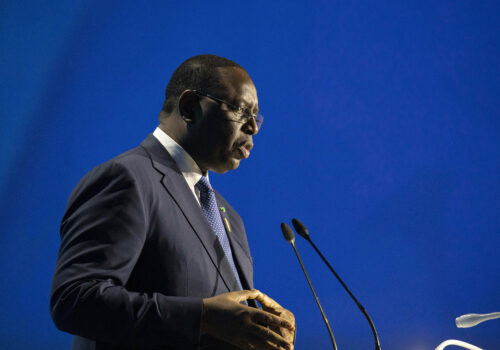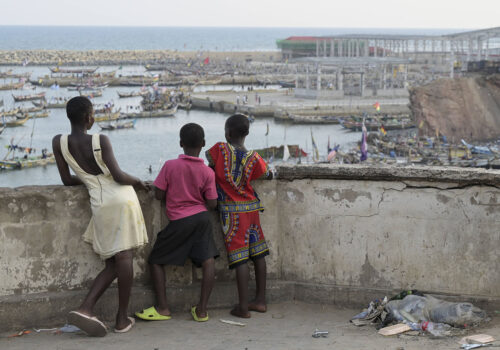How a weaker US dollar can help debt-burdened African countries
US President Donald Trump is lending Africa a helping hand—through policies that have contributed to a weaker US dollar.
Since the start of Trump’s second term, the US dollar has depreciated by roughly 12 percent against a broad basket of currencies, including many across Africa. For African economies that borrow and trade in dollars, a weaker greenback eases debt burdens and lowers import costs. In this way, a weaker dollar provides these African countries with unexpected breathing room in an otherwise difficult global financial environment.
Why do African countries rely so heavily on the US dollar?
Challenges around public debt in Africa are not a recent development, but a structural feature of the continent’s political economy. For several decades, many African governments have faced persistent difficulties in mobilizing sufficient domestic capital to meet rising expenditure demands. These constraints stem largely from the shallowness of domestic financial markets, characterized by a narrow investor base and underdeveloped institutional investors. Consequently, many countries have relied on external borrowing.
Instruments denominated in local currencies attract little demand in international markets, compelling leaders to issue debt in foreign currencies—primarily the US dollar, followed by the euro. Relying on foreign currency borrowing exposes governments to significant exchange rate risk, as currency movements remain beyond their control. The Mo Ibrahim Foundation recently estimated that more than 70 percent of Africa’s external public debt is denominated in US dollars.
External debt denominated in foreign currency is a suboptimal financing strategy that amplifies a range of macro-financial vulnerabilities. It is a short-term solution to a long-term problem. Exchange rate risk is the most obvious concern, compounded by the nature of international capital markets. Sovereign debt issued in US dollars by countries other than the United States is typically priced with a risk premium above the benchmark yield on US Treasury securities, due to perceived credit risk and broader investor sentiment toward emerging markets.
Moreover, African leaders frequently issue debt with relatively short maturities, heightening rollover risk and constraining fiscal space for long-term development planning. This dynamic results in a paradox: Governments rely on a costlier and more volatile source of financing to address structural investment needs that, by definition, require stability and predictability.
How much external debt is there?
The chart below presents the ratio of external debt-to-gross domestic product (GDP) ratio for selected African economies, alongside the nominal interest payments denominated in US dollars. In Mozambique’s case, external debt exceeds 300 percent of GDP. Aggregate interest obligations on external public debt across the continent now exceed $23 billion annually. This scale of debt service illustrates the growing fiscal burden associated with liabilities in foreign currency, which divert scarce public resources away from development priorities and render African countries more vulnerable to changes in global financial conditions.
How much debt is too much?
The ongoing accumulation of public debt in Africa—exacerbated by the COVID-19 pandemic and increasingly frequent extreme weather events—has pushed several countries to the brink of default. According to the International Monetary Fund’s (IMF) 2023 Debt Sustainability Analysis, seven African countries are already in debt distress, while an additional thirteen are classified as being at high risk. At present, the IMF has active programs with twenty-five African countries with approved commitments exceeding 21.5 billion in special drawing rights (SDR)—equivalent to around $30.9 billion. SDR is an international reserve asset created by the IMF, valued against a basket of major currencies, and used to supplement member states’ foreign exchange reserves.
Among IMF instruments, the most widely used in Africa is the Extended Credit Facility (ECF)—the organization’s flagship concessional lending tool for low-income countries. The ECF provides long maturities, zero-interest financing, and reform support. It is intended to help enable governments to address persistent balance-of-payments pressures and advance structural reforms. Typically, countries request an ECF arrangement when short-term financing proves insufficient to meet prolonged macroeconomic and developmental challenges. The chart below presents a more comprehensive picture of the IMF’s current engagement in Africa.
How a weaker dollar is helping
Any precise assessment of Africa’s external debt trajectory must consider the value of the US dollar. For African countries, where more than two thirds of external public debt is denominated in US dollars, a depreciation of the dollar relative to local currencies temporarily reduces the cost to service debt and creates additional fiscal space for the government.
In this sense, a weaker dollar provides a measure of relief, not strain. To be sure, the value of a free-floating currency can change rapidly, reversing positive fiscal impact. It is important to note that a weaker dollar can also negatively impact African exports to the United States, as it makes African-made products more expensive relative to the stronger dollar. The trade landscape between the United States and Africa is further complicated by the recent expiration of the African Growth and Opportunity Act, a US trade program that grants duty-free access to the US market for thousands of products from eligible sub-Saharan African countries to promote economic growth and development.
The trend of a weaker dollar is likely to continue. Since the beginning of Trump’s second term, the US dollar has depreciated by roughly 12 percent against a set of major African currencies, yielding an estimated $2.3 billion in annual savings on interest payments. This additional fiscal space provides governments with a unique opportunity to either front-load debt repayments or accelerate the implementation of development projects.
How African countries can seize this momentum
African countries could use the additional fiscal space to pursue front-loading debt repayments. In its April 2025 Regional Economic Outlook for Sub-Saharan Africa, the IMF commends the region for reducing public debt levels. However, the primary driver of lower public debt has been the GDP deflator—in other words, inflation—followed by real GDP growth, while the nominal stock of debt has remained broadly unchanged. The fiscal savings resulting from a weaker US dollar present an opportunity to accelerate principal repayments, strengthen the fiscal position, and bolster market confidence in the long term.
Another possible use of the extra resources would be to accelerate large-scale development projects aimed at boosting growth in the private sector—while avoiding the subsidization of private consumption—and enhancing productivity. It is important for governments to avoid welfare projects that would increase daily spending, creating long-term fiscal liability when conditions become less favorable. Instead, African governments should seek to leverage their young populations by expanding access to education and digital services, which could unlock innovation potential and lead to sustainable growth.
Path toward the domestic debt market
In a long-term strategy, echoing the IMF’s recommendations, African countries should intensify their efforts to develop domestic debt markets as the foundation for long-term fiscal sustainability and effective debt management. Strengthening local markets would yield several benefits. First, issuing debt in local currency eliminates exchange-rate risk, insulating public finances from external currency fluctuations. Second, if appropriately designed, domestic markets can facilitate the extension of debt maturities, thereby enhancing stability and predictability in public debt management. Third, a broader domestic investor base ensures that interest payments remain within the local economy, supporting financial sector development and reducing the transfer of national resources abroad.
So, one might ask: What has prevented African countries from working toward a more robust domestic debt market? The answer lies in the complexity of the issue, which requires a long-term plan. Macroeconomic challenges such as a shallow investment base, underdeveloped financial infrastructure, and institutional weaknesses demand a well-anchored strategy. It is important to start this process when fiscal conditions are more favorable. Eliminating central bank deficit financing would be a welcome first step forward.
By most indications, the Trump administration did not set out with the intention to weaken the US dollar. But a reality of the second term so far has been a weaker dollar, and this outcome carries far-reaching implications. For African countries with external debt denominated in dollars, this development offers a welcome reprieve, easing fiscal pressures and creating new policy space. It’s now up to national authorities to proactively seize this opportunity, as the current environment of a weaker dollar may prove temporary. The moment is favorable—decisive action today can translate into lasting economic resilience tomorrow.
Bart Piasecki is an assistant director at the Atlantic Council’s GeoEconomics Center.
Juliet Lancey, a young global professional at the GeoEconomics Center, contributed research to this article.
Further reading
Wed, Oct 1, 2025
Former Senegalese President Macky Sall on designing an international architecture with Africa in mind
New Atlanticist By Katherine Golden
At a Front Page event, Sall advocated for UNSC seats, affordable loans, and flexibility on climate commitments for Africa.
Tue, Dec 10, 2024
Ghana’s president: Efficiency, transparency, and reform is Africa’s path to debt sustainability
New Atlanticist By
Africa’s debt crisis is a global challenge, but lessons from Ghana’s restructuring success highlight the power of reforms and collaboration to restore financial stability.
Thu, Aug 14, 2025
Biased credit ratings are costing Africa billions—and worsening its health crises
AfricaSource By
As debt payments outpace spending on health and education, African leaders are renewing calls to overhaul a credit ratings system they say punishes reform and deepens fragility. Zambia is a case in point.
Image: A trader displays new Congolese currency bills in the Democratic Republic of Congo's capital Kinshasa, July 3, 2012. REUTERS/Jonny Hogg



